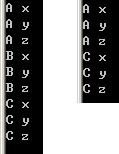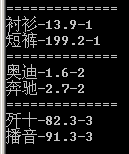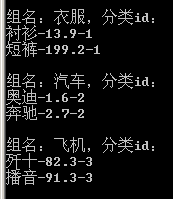- Query object (list variable in the example above) is IEnumerable < T > or IQueryable < T > type
- Query returns are also IEnumerable < T > or IQueryable < T > types
Linq is divided into five categories: Linq to objects, Linq to DataSets, Linq to SQL, Linq to Entities, Linq to XML.
Simple use
Type Query Variables=
from temporary variable in collection object or database object
[where conditional expression]
[order by condition]
select Temporary Variables or Queried Values in Temporary Variables
[group by](1) General inquiry:
// data source
int[] arr = new int[] { 0, 1, 2, 3, 4, 5, 6, 7, 8, 9 };
// Linq Query
var result =
from item in arr // Declare the temporary variable item and specify that it is an element in the array arr, item
where item > 4
select item; // Add the query result (item) to result
// Traveling through Linq query results is actually a "Linq query" that is executed with foreach, that is, "Linq query" will not be executed before foreach executes.
foreach(int i in result)
{
Console.Write(i); //Output 56789
}(2) Query and sort:
int[] arr = new int[] { 0, 1, 2, 3, 4, 5, 6, 7, 8, 9 };
var result =
from item in arr
where item > 4
orderby item descending // Descending arrangement
select item;
foreach(int i in result) {
Console.Write(i); // Output: 98765
}(3) Type conversion:
int[] arr = new int[] { 0, 1, 2, 3, 4, 5, 6, 7, 8, 9 };
var result =
from item in arr
where item > 4
select string.Format("Value:{0} ", item); // Convert to String type and format it
foreach(string i in result) { // Change variable i to string type
Console.Write(i); // Output "Value: 5 Value: 6 Value: 7 Value: 8 Value: 8 Value"
}(4) Query for a single value:
int[] arr = new int[] { 0, 1, 2, 3, 4, 5, 6, 7, 8, 9 };
int result0 = (from item in arr where item > 4 select item).Count(); // The whole sentence is hugged by a pile of () and counted.
int result1 = (from item in arr where item > 4 select item).Max(); // Query maximum
Console.WriteLine(result0); //Output: 5
Console.WriteLine(result1); //Output: 9from subquery
class Program
{
static void Main(string[] args)
{
// Create a generic variable arr similar to a two-dimensional array to store student information
List arr = new List
{
new Student {name = "Lining", scores = new List{11, 12, 34} },
new Student {name = "ADI", scores = new List{11, 16, 34} },
new Student {name = "Nike", scores = new List{18, 12} },
};
// Query the records of students with scores greater than 15
var result =
from stu in arr // Declare temporary variable stu
from sc in stu.scores // Declare that the temporary variable sc is used for "sub-queries".
where sc > 15
select new {name = stu.name, score = sc}; // The query results are "projected" into a new object with two attributes, name and score.
foreach (var s in result) {
Console.WriteLine(s.name + ": " + s.score);
}
}
}
class Student
{
public string name; // Name of student
public List scores; // A student's score. A student can have more than one score.
}Output results:
Li Ning: 34 Adi: 16 Adi: 34 Nike: 18
In the above example, each student has been associated with his score several times, and the query results are stored in a new object (new {...}).
Associating multiple data sources
// Define data sources
char[] upper = { 'A', 'B', 'C' };
char[] lower = { 'x', 'y', 'z' };
// Associate two data sources
var result0 =
from up in upper
from lo in lower
select new {upper = up, lower=lo};
foreach (var item in result0) {
Console.WriteLine(item.upper + " " + item.lower);
}
// Associate two data sources and filter by condition
var result1 =
from up in upper
from lo in lower
where up != 'B'
select new { upper = up, lower = lo };
foreach (var item in result1) {
Console.WriteLine(item.upper + " " + item.lower);
}The two output results are as follows:

Grouping
(1) Simple grouping
class Program
{
static void Main(string[] args)
{
// Define data sources
List<Product> arr = new List<Product>
{
new Product{name = "shirt", price = 13.9m, cid = 1},
new Product{name = "shorts", price = 199.2m, cid = 1},
new Product{name = "Audi", price = 1.6m, cid = 2},
new Product{name = "Benz", price = 2.7m, cid = 2},
new Product{name = "The J-10", price = 82.3m, cid = 3},
new Product{name = "Broadcasting", price = 91.3m, cid = 3},
};
var result =
from p in arr
group p by p.cid;
// Traversal Groups
foreach (var gp in result) {
Console.WriteLine("==============");
// Traveling through each group member
foreach (var pd in gp) {
Console.WriteLine("{0}-{1}-{2}", pd.name, pd.price, pd.cid);
}
}
Console.Read();
}
}
class Product
{
public string name; // Name of commodity
public decimal price; // commodity price
public int cid; // Classification of commodities
}Grouping here is not grouping in SQL. Grouping in SQL is mainly used for grouping statistics. The grouping here is to group the original "one-dimensional data" into "two-dimensional data" according to certain rules, and the output results are as follows:

(2) Group Object Processing
static void Main(string[] args)
{
// Define data sources
List arr = new List
{
new Product{name = "shirt", price = 13.9m, cid = 1},
new Product{name = "shorts", price = 199.2m, cid = 1},
new Product{name = "Audi", price = 1.6m, cid = 2},
new Product{name = "Benz", price = 2.7m, cid = 2},
new Product{name = "The J-10", price = 82.3m, cid = 3},
new Product{name = "Broadcasting", price = 91.3m, cid = 3},
};
List classList = new List
{
new Pclass{cname="clothes", cid = 1},
new Pclass{cname="automobile", cid = 2},
new Pclass{cname="aircraft", cid = 3},
};
var result =
from p in arr
// G is actually a group in the format < Vey, Values >
// Key is cid for the group
// Values is the set of elements
group p by p.cid into G
from cls in classList
where G.Key == cls.cid // Association Group G and classList Collection
select new {cname = cls.cname, cid = cls.cid, gplist = G};
foreach (var gp in result)
{
Console.WriteLine();
Console.WriteLine("Group name:{0},classification id: ", gp.cname, gp.cid);
foreach (var pd in gp.gplist)
{
Console.WriteLine("{0}-{1}-{2}", pd.name, pd.price, pd.cid);
}
}
}
}
class Pclass
{
public int cid; // Classification id
public string cname; // Category name
}
class Product
{
public string name; // Name of commodity
public decimal price; // commodity price
public int cid; // Classification of commodities
}The key to the above code lies in the understanding of "into G". The execution process of the query part is as follows:
The first step is to perform grouping, divide a group (cid=1 group) and store it in the temporary variable G; the second step is to associate the grouping G with the set of classList s and store the qualified results in the format specified by select. After the first group is processed, the second group is processed according to the above steps (cid=2), and so on.
Output of program execution:

(3) Delete grouped objects
static void Main(string[] args)
{
List sts = new List
{
new Student{id= 1, name="Lining", cid = 1},
new Student{id= 2, name="Li Na", cid = 2},
new Student{id= 3, name="Nike", cid = 3},
new Student{id= 4, name="ADI", cid = 2},
new Student{id= 5, name="Benz", cid = 1},
new Student{id= 6, name="sign up", cid = 3},
};
var result =
from s in sts
group s by s.cid into G
select new {
id = G.Key,
list = (
// Excluding students whose id is even
from m in G
where (m.id % 2 != 0)
select m
)
};
foreach (var item in result) {
Console.WriteLine("Cid: {0}", item.id);
foreach (var s in item.list) {
Console.WriteLine("{0}-{1}-{2}", s.id, s.name, s.cid);
}
}
}

let clause
Used to create a new temporary variable in a query
static void Main(string[] args)
{
// Define data sources
List sts = new List
{
new Student{id= 1, name="Lining", cid = 1},
new Student{id= 2, name="Li Na", cid = 2},
new Student{id= 3, name="Nike", cid = 3},
new Student{id= 4, name="ADI", cid = 2},
new Student{id= 5, name="Benz", cid = 1},
new Student{id= 6, name="sign up", cid = 3},
};
var result =
from s in sts
let fullname = s.id + s.name
select string.Format("id: {0},Full name:{1}", s.id, fullname);
foreach (string i in result) {
Console.WriteLine(i);
}
}

Reprinted at: https://www.cnblogs.com/rainman/archive/2013/06/01/3111752.html